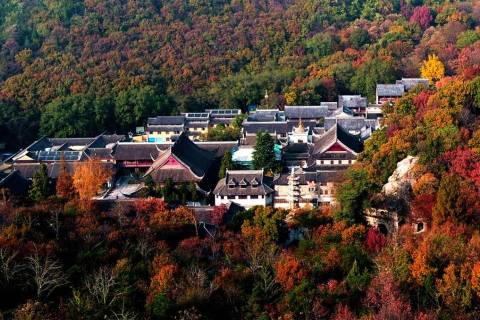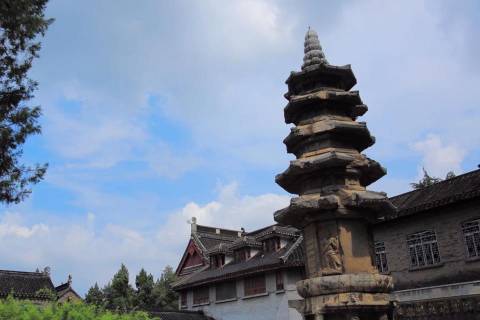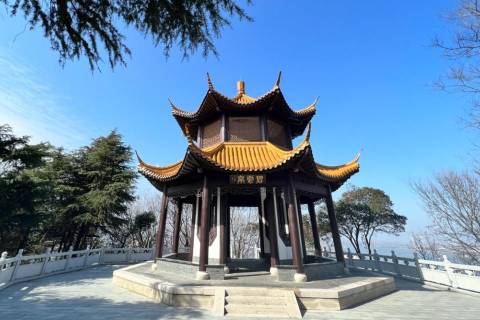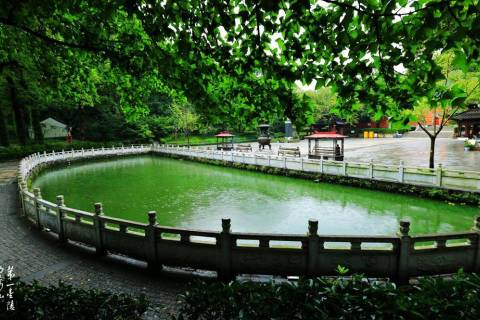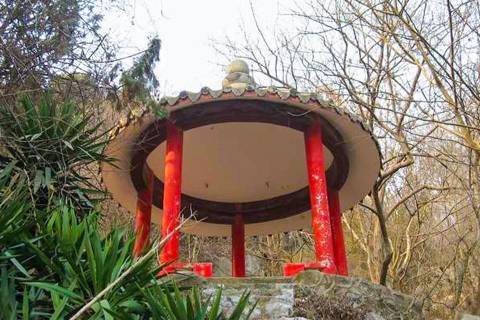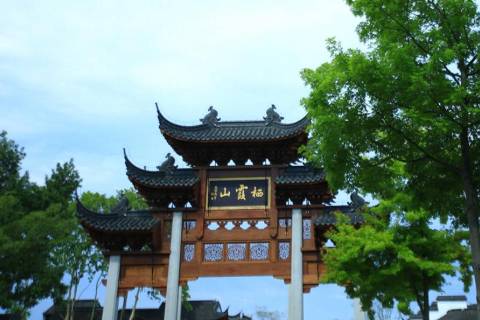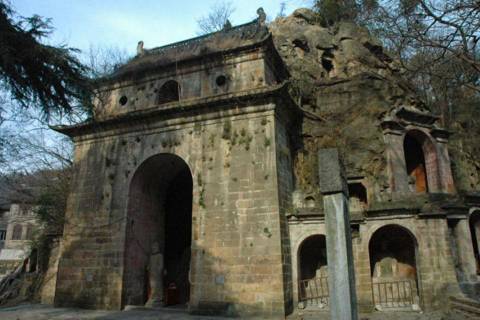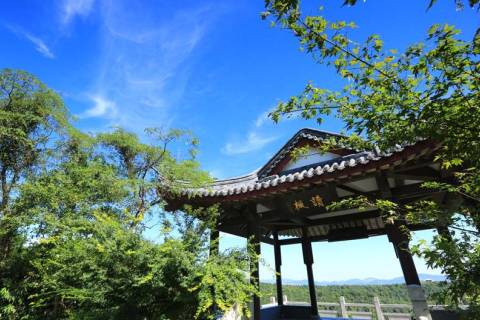Scenic introduction
Qixia Mountain ancient photo Hill, also known as the umbrella mountain, is located in the northeastern suburb of Nanjing, surrounded by mountains, north of the Yangtze River, the total area of 860 hectares scenic Fengxiang peak elevation of 286 meters. Was Emperor Qianlong called "the first Jinling Ming Xiushan".
Since the Ming Dynasty, there are "autumn Qixia," said, "Qixia Danfeng" as one of the new King of Jinling, Qixia many types of leaves, especially in Maple, including maple, Acer palmatum, Maple, beech, Pistacia chinensis, etc., every late autumn, the mountain is popular in Man Shan, like the sunset habitat fall, magnificent, with its unique charm to attract many tourists come to watch for the four Hongye ornamental scenic one.
Qixiashan monuments all over the mountain beautiful, deep cultural heritage, known as "a Qixiashan, half of Jinling" in the world. There are five king 14 emperor in the history of Qixiashan, of which six under the Emperor Qianlong Jiangnan, five in Qixiashan, the scenic area has a national heritage conservation units 3, provincial and municipal cultural relics protection units, historical sites More than 80. A blend of religious culture, imperial culture, green culture, celebrity culture, geological culture, stone culture, tea culture. Mountain peaks, rocks, springs, deep stream and pines, cypress, peach, red leaves seamless, natural Tiancheng. Sui stupa, Tang Ming Zheng Jun monument, Thousand Buddhas Cave, Yu Wang monument, Qianlong palace, Wansong mountain house, if the Taiwan, Tai Xu Ting, then Shan Ting, Lu Yu Chazhuang arch Youyou blue. The Qixia Temple, one of the four jungles, is located in the western foot of Qixia Mountain. The sound is melodious, and it is like a paradise on earth.
Qixiashan is also extremely rich in geological connotation, many fossils, is the name of many names, by experts known as the "Natural Geological Museum", "Earth Science Textbook."
In recent years, scenic spots in the construction of scenic spots, landscaping, cultural relics protection, ecological protection and other aspects of great development, and gradually make this into the natural landscape, stone forest landscape and historical and cultural landscape as one of the "first Jinling Mingxiushan" Become a tourist, tourism, pilgrimage, expedition as the main function of the tourist destination.
A Qixiashan, half Jinling history
Qixiashan known as "the Six Dynasties and wins the track," said in the Qing Dynasty was classified as "Jinling forty-eight King" one of the "Qixiashan, half of Jinling" in the world. In the history, there were five kings and fourteen emperors boarding Qixiashan, more than 80 historical and historical relics, and gathered the religious culture, imperial culture, green culture, celebrity culture, geology culture, stone culture and tea culture. One of the four jungles, "the ancient Qixia Temple, located in the Qixia Shanxi Lu.
Opening hours: 7: 00-17: 00
Ticket prices: 25 yuan / person (off - season);Autumn Hongfeng Festival has been raised during the festival, the ticket price is 40 yuan / person (peak season)
To explain the service
In the price: 30 people (including 30) 80 yuan / field, more than 30 90 yuan / field.
Note: Guide to explain the procedure please go to call center, booking Tel: 85761831, explain line A, B two, each explain the time of 60 minutes.
Line A: Well Hall - Rainbow Mirror - Bell and Drum Tower - Ming Zheng Jun Monument - Maitreya Temple - Pilu Po Hall - Stupa - Thousand Buddha Rock
Line B: Scenic Entrance - Rainbow Mirror - Bell and Drum Tower - Hushan Lingyun Plank Road - Pik Wan Ting - Tiger Hill - Reading Maple Pavilion
Tourist Service Center
Qixiashan Tourist Service Center is located in the main entrance of the scenic spot. It is a multifunctional service place including consultation, tour guide, special service and medical aid. It has tourist lounge, movie hall, special service area and recreation area. Can provide the following services:
1, travel advice, help and complaints:Tel 85761831
2, the clinic: With a stretcher, medicine cabinet, a simple external medicine, providing simple medical assistance;
3, small pieces of storage:Tourists can deposit tickets in accordance with the registration process free hosting package;
4, free use of items:Wheelchairs, stroller, umbrella, crutches 5, free guide map, tour map, multimedia tourism inquiries;
Position realm
Qixia Mountain is located in Qixia District, north-central, Qixia Mountain has three peaks, the main peak San Maofeng 286 meters above sea level, also known as Fengxiang Feng; Northeast is a mountain Longshan; Geographical coordinates of latitude 32 °, 119 ° east longitude.
topography
Qixia mountain is Maoshan wedge into the north branch of Nanjing, the whole mountain range of peaks. Qixiashan mountain from south to north by the three mountains, the south for the scenery Kong, in the 1000 Buddha Ridge, the North by the black stone when, flat hill, San Maofeng composition. Qixiashan area of about 4 square kilometers, mainly by the limestone, sandstone and other components, the northern foot of granite distribution by the ribbon.
Qixiashan consists of three mountains and two streams. The peak (the main peak) is the highest, conical, 284.7 meters above sea level, said Fengxiang Feng, because the ancient temple of a Mao Gong, it is also known as San Maofeng. Mid-peak stretches eastward, a pulse meandering down and said Dongfeng, shaped if Wolong, the name of Longshan. Peak in the west side of the ridge if the volt tiger, said Hu Shan. Between the peak and the East peak of a valley, said the peak stream, the peak and the West between a valley, called peach stream.
Qixia climate
The average annual temperature is 19.6 ℃, the extreme maximum temperature is 38.8 ℃, the extreme minimum temperature is -3.7 ℃. The annual average precipitation is 1530.1 mm, the annual maximum precipitation is 2371.4 mm and the minimum is 2371.4 mm. Precipitation 1091 mm; frost-free period 322 days.
Traditions
During the Spring Festival, to Qixia ancient temple bell prayer is the traditional activities of Nanjing citizens and tourists. In ancient times every Lantern Festival period, the villagers around the Qixia Hill should be on the Dragon King, to worship the Dragon King, the family has long been the practice of playing the dragon spread so far.
The origin of the name
"Qixia" is not the beginning of the mountain name. It is said that ancient mountains rich in wild ginseng, angelica, Shouwu, Poria, licorice and other herbs, nourishing health (that is, health) effect, named "photo Hill. Qixia Mountain at first unknown, since the Southern Dynasties, the Qixia Shan famous for the temple, a Buddhist holy sites in China. The Southern Qi Dynasty, the plains of the Ming Dynasty monk Shao, its house "Qixia fine homes" gift to the testimonies Zen master, the court will be converted into a temple, and named "Qixia Temple", also because of the temple named "Qixia mountain".
Anecdotes of legend
Legend, the founder of Qixia Temple monk Shao had dreamed of the West rock wall Buddha, so determined in this chisel Buddha; after his death, his son in the Southern Qi Yongming two years (484 years) began with monk Zen master in the West The three Buddhist statues were completed, the three known as the "three West St.", the temple, also known as the "three shrines." Southern Liang Datong six years (540 years) on the three Buddhist shrines appeared on the Buddha, alarmed Qi Liang aristocracy, so have come to stone sculpture. So from the Southern Dynasties Qi Yongming two years to the Liang Tianjian ten years (484-511 years) gradually cut into the Buddha statue has 515, all Buddha statues or 56 a niche, or seven or eight a room, divided in 294 shrines in. Later, the Tang, Song, Yuan, Ming dynasties have been in the Shamao peak cut, even the Southern dynasty, including a total of 700. Buddha statue of the high Shu Zhang, small only Ying Chi, known as Thousand Buddha cliff.
Plant resources
As of 2012, Qixiashan varieties of leaves as many as 10 species, including Hongfeng, Liquidambar, Triangular Maple, Pistacia, Zelkova, tallow, salt-wood, Tree more than 500 strains, all kinds of colored leaves more than 50 million trees.
Vascular plants 589 species (including cultivated species), 500 kinds of wild plants (including species under the level), belonging to 342 genera and 108 families. Including 11 species of 14 genera, 19 species of ferns, 4 species of gymnosperms, 4 families of gymnosperms, and 477 species of angiosperms. Six new species (including Pteris vittata, Ophiopogon japonicus, Ophiopogon japonicus, Caragana sibiricum, Phyllanthus emblica and Sorghum bicolor) were found in Jiangsu Province.
235 medicinal plants, can be divided into mountain grass, grass, wet grass, poisonous grass, weeds, stone grass, accounting for Qixiashan 47.09% of the total number of plants.
8 species and 8 species of rare plants. Which are wild soybean, short spike bamboo and Ming Codonopsis. Five cultivated species belong to five genera, namely, the national second-grade protected plant Ginkgo biloba, the national first-grade protected plant Metasequoia glyptostroboides, the national secondary protection plant Eucommia ulmoides, the national Two protected plants Liriodendron.
Animal resources
Wild animal resources According to the Chinese zoogeographical division, the animal fauna of Qixia District belonged to the Oriental region in the Indian sub-area of Central China Eastern hilly plain sub-area. In the ecological geography fauna, is a subtropical forest irrigation, grassland - farm animal groups. The former is the dominant species of the ungulate in the middle and lower reaches of the Yangtze River. It is rare for Chinese alligators, dolphins, porpoises and Chinese sturgeons to be endemic animals.
mineral resources
As of 2012, Qixia Mountain is rich in lead, zinc, silver, limestone and other mineral resources, lead, zinc, silver and other mining has been for many years, of which more than 200 million tons of lead and zinc metal, is the largest lead deposit in East China. Non-metallic minerals are mainly dolomite, limestone, gypsum, clay, gangue, coal, etc .; metal ore is widely distributed, mainly lead-zinc, silver, gold, manganese and so on. Qixiashan mineral to lead, zinc, silver-based



